- By Dan Veaner
- News
 Print
Print
Tompkins and Cayuga Counties' oldest log cabin came home to Lansing last month, though it's journey is far from over. Built by the North family in the mid-eighteenth century, the cabin has been behind the Cayuga Museum in Auburn for 49 years. When museum officials decided to use the space for other purposes, the Town of Lansing faced deadline for removing the building -- or it would be demolished and removed. "It's all here now," says Deputy Highway Superintendent Charlie Purcell. "The next step is deciding where they want to place it."
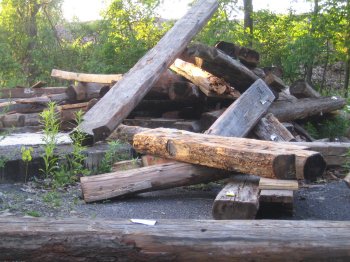
The cabin rests in a 'controlled pile' on Highway Department premises
Originally built out of rough hemlock logs in 1749 near the junction of Conlon and Searles Roads, the cabin has traveled quite a bit. In 1844 it was moved north to 578 Conlon Road, where it was eventually covered with modern clapboard and it's origins were forgotten. In 1958 it was rediscovered when some of the clapboard siding was removed, and was moved again to the Cayuga museum. Until six years ago the museum used the cabin for historical exhibits, but since then has used it for storage.
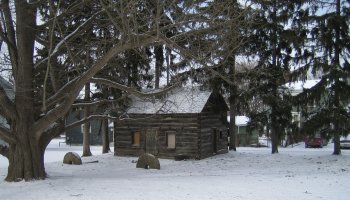
The log cabin spent 49 years behind the Cayuga Museum in Auburn
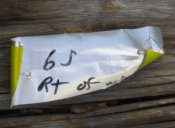 Over a year ago Lansing's Deputy Supervisor Bud Shattuck entered into negotiations with the museum to bring the structure home to Lansing. But with no funding for the move the project stalled. Late last year museum officials told Shattuck that the Town had until the first of this year to remove the cabin. At that point Shattuck along with a small committee of interested residents decided on a plan of action that would make rescuing the cabin a priority. While moving the cabin intact was originally considered, the museum's deadline and lack of funding pushed Shattuck to adopt another plan: the cabin would be disassembled by the Town Highway Department after tagging each log so it could be properly reassembled, and trucked to Lansing using the department's trucks.
Over a year ago Lansing's Deputy Supervisor Bud Shattuck entered into negotiations with the museum to bring the structure home to Lansing. But with no funding for the move the project stalled. Late last year museum officials told Shattuck that the Town had until the first of this year to remove the cabin. At that point Shattuck along with a small committee of interested residents decided on a plan of action that would make rescuing the cabin a priority. While moving the cabin intact was originally considered, the museum's deadline and lack of funding pushed Shattuck to adopt another plan: the cabin would be disassembled by the Town Highway Department after tagging each log so it could be properly reassembled, and trucked to Lansing using the department's trucks.
Several weeks ago the logs were tagged, but because of winter weather and spring road resurfacing, the schedule couldn't spare workers to get the cabin until the end of May. With a plan in place the museum extended their deadline. They began disassembling the structure on May 29th, and finished the job the next day. "We sent our gradeall up," Purcell says. "Five guys took it apart piece by piece, stacked it on the trailer, brought it back here and unloaded it."
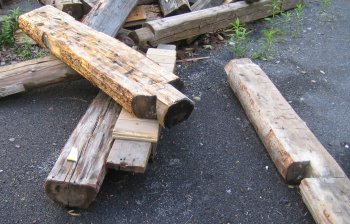
Tongues match grooves in the logs to hold the cabin together
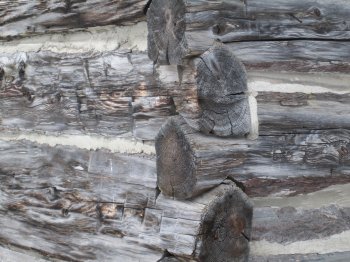
When assembled the logs fit tightly together
Purcell says that the cabin came apart more easily than expected, but some of the logs were in bad shape. "You always worry about what's securing it," he says. "It was a little easier than anticipated."
It took three trips to get the logs back to the Highway Department grounds, where they are being stored on a concrete slab to help prevent further rotting of the wood. "It's in some sort of organized pile," Purcell says. "At this point I don't know where they're going next with it. The next step is deciding where they want to place it."
That is the question. Shattuck says that saving the cabin was the first priority, but there is no timetable or clear plan for reassembling it. Resident Chris Muka had offered to donate land on Salmon Creek Road, but after looking at the property Highway Superintendent Jack French determined that it wasn't large enough to hold the cabin and provide parking for visitors. Other sites are being considered, including a piece of land near Myers Park that the Town already owns. Some officials favor that site, because it is less remote than the Salmon Creek Road plot, so would be more accessible to visitors.
But another challenge is restoring the two storeyed cabin. The 18' x 24' building's four walls are original, but the roof was not. So even if all the logs were in perfect shape a new roof would have to be constructed and materials purchased. The rough hewn logs are slotted to fit together, and any replacements will have to be carved to match the slots in the original logs. "There were quite a few of the logs in pretty bad shape," Purcell says.
Another challenge will be finding labor to restore the cabin. Several months ago Muka suggested he could find volunteers to help him rebuild it, and town officials are hoping that he will still be interested in pursuing that idea. But for now the Town has bought time to figure out how and where to restore it so that one of the oldest pieces of Lansing's history can be restored and displayed.
----
v3i23

The cabin rests in a 'controlled pile' on Highway Department premises
Originally built out of rough hemlock logs in 1749 near the junction of Conlon and Searles Roads, the cabin has traveled quite a bit. In 1844 it was moved north to 578 Conlon Road, where it was eventually covered with modern clapboard and it's origins were forgotten. In 1958 it was rediscovered when some of the clapboard siding was removed, and was moved again to the Cayuga museum. Until six years ago the museum used the cabin for historical exhibits, but since then has used it for storage.

The log cabin spent 49 years behind the Cayuga Museum in Auburn

Tags Mark Each Log for Reassembly
Several weeks ago the logs were tagged, but because of winter weather and spring road resurfacing, the schedule couldn't spare workers to get the cabin until the end of May. With a plan in place the museum extended their deadline. They began disassembling the structure on May 29th, and finished the job the next day. "We sent our gradeall up," Purcell says. "Five guys took it apart piece by piece, stacked it on the trailer, brought it back here and unloaded it."

Tongues match grooves in the logs to hold the cabin together

When assembled the logs fit tightly together
It took three trips to get the logs back to the Highway Department grounds, where they are being stored on a concrete slab to help prevent further rotting of the wood. "It's in some sort of organized pile," Purcell says. "At this point I don't know where they're going next with it. The next step is deciding where they want to place it."
That is the question. Shattuck says that saving the cabin was the first priority, but there is no timetable or clear plan for reassembling it. Resident Chris Muka had offered to donate land on Salmon Creek Road, but after looking at the property Highway Superintendent Jack French determined that it wasn't large enough to hold the cabin and provide parking for visitors. Other sites are being considered, including a piece of land near Myers Park that the Town already owns. Some officials favor that site, because it is less remote than the Salmon Creek Road plot, so would be more accessible to visitors.
But another challenge is restoring the two storeyed cabin. The 18' x 24' building's four walls are original, but the roof was not. So even if all the logs were in perfect shape a new roof would have to be constructed and materials purchased. The rough hewn logs are slotted to fit together, and any replacements will have to be carved to match the slots in the original logs. "There were quite a few of the logs in pretty bad shape," Purcell says.
Another challenge will be finding labor to restore the cabin. Several months ago Muka suggested he could find volunteers to help him rebuild it, and town officials are hoping that he will still be interested in pursuing that idea. But for now the Town has bought time to figure out how and where to restore it so that one of the oldest pieces of Lansing's history can be restored and displayed.
----
v3i23



